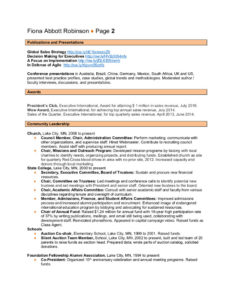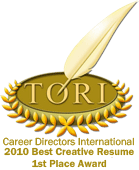
Page 2 sections can add value to your resume.
Your resume contains standard sections: the Summary, Experience, and Education sections appear in every resume.
There are other sections you can use if they are relevant to your background and to your target position. These sections, usually appearing on the second page of the resume, include awards, publications, presentations, memberships, community involvement, and interests. We’ll take them one by one to explain the content and use.
The sections are in the order they should appear in on your resume, unless one takes precedent above others. For example, you might have a relatively insignificant award 10 years ago; however, you are heavily involved in your community associations, and looking for a sales position. In this case, your community involvement could be the first section after Experience.
Within each section, the items should be listed in reverse chronological order, meaning the most recent entry is listed first.
Awards
This section can also be called Recognition, Honors, or Accolades on a presentation resume. In an ATS resume, use the heading Awards.
List the name of the award first, followed by the awarding group, city, and state; what you did that resulted in the award; and the month and year you received the award.
Each listing looks like this:
Toast of the Resume Industry (TORI), Career Directors International, first-place award in Creative Resume category, October 2010.
If you have many awards from a number of sources, you can further categorize them to make the section easier to read. For example, you might have Internal Awards and External Awards as categories. Company Awards and Community Awards might be other useful categories. You could also divide them by industry categories such as Marketing Awards and Sales Awards.
If you are changing careers, consider carefully whether your past awards are relevant to your present career target. For example, you may have a number of awards in sales. If you are applying for management positions, they may be irrelevant, but if you are applying for sales management positions, they are useful.
Publications
If you have published books, articles, white papers, or other material relevant to your current career target, list them under a Publications heading.
List the title of the article, all authors names if the article was co-authored, publication or web site where the article appeared, publisher (if different), city and state of the publication if not online, month and year it was published, and a link to the article if it appears online.
For a book, list the title, all authors names if co-authored, publisher, city and state of publication, and month and year published.
Construct each listing so:
8 Ways to Get the Resume You Really Want, CareerDirectors.com, September 2016, http://careerdirectors.com/8-ways-get-resume-really-want/
Use the full link or a shortened link to the publication, but don’t link the title. Occasionally, your resume will be printed, and the link won’t be available.
Presentations
Presentations are verbally delivered rather than written material. These might include speeches, conference addresses, sales pitches, bid presentations, teleconferences, webinars, and others.
List the title of the presentation, all presenters if there were more than just you, the audience, name of the group if different from the audience, city and state in which the presentation occurred (unless it was a webinar), month and year it occurred, and a link to the presentation if it is available online.
Each listing will look like this:
Women Returning to Work; Amy Gleklen, Jeri Hird Dutcher, and Kara Carluccio, University of Pennsylvania Alumni, webinar hosted by University of Pennsylvania Career Services, April 2014, http://ow.ly/YmcB305BafH
In some cases, it is useful to combine the Publications and Presentations sections.
Professional Memberships
Restrict the items in this group to professional involvement. That means professional associations, work groups, and committees. The point of listing your memberships is to highlight your impact on your industry, so the more active you are, the more credibility you have.
Each item includes the name of the group, a brief explanation of the group if it is not obvious from the name, your title, important activities you’ve performed in that role, (date range of the role), city and state in which the group is located, and the date range of your involvement, including the month and year.
Each entry looks like this:
Career Directors International, international association of resume writers and career coaches, Education Committee Member (2014 to present), curated and edited educational publications for members, Melbourne, FL, October 2009 to present.
Community Involvement
Some companies, careers, or positions place importance on your involvement in your community. For example, if you are applying for a position as a diversity director, VP Marketing, or sales representative, your prospective company may value your relationships in the wider community as a way of connecting the company and community. You may, indeed, be the “face“ of the company in your community.
For these types of positions, list roles in which you are involved in your community, such as Chamber of Commerce, church, school, and university organizations, service organizations, charities and nonprofits, and any other type of volunteer work you do.
Each item includes the name of the group, a brief explanation of the group if it is not obvious from the name, your role or title, the main activities you perform if it isn’t obvious by your title, city and state in which the group is located, and the date range of your involvement, including the month and year.
An entry will be structured like this:
Native American Flute Circle, Leader and Instructor, The Village of Riverview, Detroit Lakes, MN, June 2016 to present.
Hints: Do not call this section Community Service, as that is the term often used for the work done by prisoners and others making societal reparations.
In some cases, you can combine professional memberships and community involvement into one category.
Interests
In US resumes, this is a little-used category. Unfortunately, most US companies are not interested enough in your work-life balance that they want to read about how you spend your spare time.
I recommend including it only if your extracurricular activity is closely related to your target occupation. For example, if you are targeting a type of sales that lends itself to relationship-building, golf and book clubs may be worth listing. Always be aware of the appearance of competition for your time and attention. Your prospective employer will not be impressed with hobbies that take you away from work.
If rewriting your resume has been stopping your job search, contact me today to talk about how to do the work without the pain.
Related:








